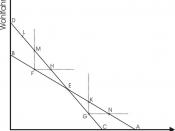1.
Booth
-reduction of water to farm
-removal of dam
-or damages
Dunlop
-built dam
-irrigation purposes
A)
i)A court taking a utilitarian view would see whether there is a solution which would maximize total social utility. Therefore 2 situations arise: Situation 1, Dunlop removes the dam and Situation 2, damages are paid to Booth. In Situation 1, the court would have to find out whether taking away the dam creates a greater gain to Booth and creates a minimal loss to Dunlop, whether the amount gained by Booth is higher than the loss to Dunlop. Since the cost of building a dam is large the court might find that the loss to Dunlop would be greater than the gain for Booth if the dam were to be removed.
This then brings up Situation 2. The court would now rule on whether damages should be awarded to Booth. The court would decide that the losses to Booth are large enough so Dunlop who is gaining from the improved irrigation would pay damages.
ii)If the court took the view of Rawls then it would figure that the cost of building the dam and getting rid of it would be too large and therefore only be left with one situation and that is to pay damages incurred by Booth because of the loss of water flow to his farm. This follows the Rawlsianisan criteria because by paying Booth damages the court would be improving the situation of someone less fortunate and therefore help in making someone in a weaker situation stronger. The court would try to compensate to make equality in society.
iii)If a court were to look at the case of Booth v. Dunlop using the Pareto efficiency criterion, it would find that by Dunlop building the dam Pareto efficiency would...


